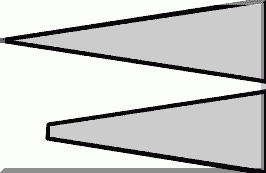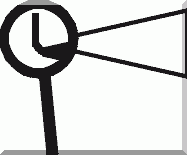The edge
sharp & dull

Sharpness and dullness are defined as the edge sides meeting at a single point and a surface, respectively. This scheme shows a sharp and a dull blade.
strength
An edge should not chip off during adequate usage. Thin, weak and small-angled edges can handle delicate objects. The razor's 15-20* edge is an ideal compromise between sharpness and strength.
serrations
Under the microscope, even a perfect edge looks serrated. A perfect smooth edge would be ideal because it would split the molecular bonding of the object. Serrations act like a saw. The purpose of razor sharpening is to create a smooth edge, and to take advantage of the inevitable serrations as much as possible.
burr

Sharpening approaches the sides of an edge, forming a ragged, rough edge which is so weak that it bends away from the sharpening medium, as the scheme shows. This so called burr feels sharp first, but it is thin and weak and willl break away soon, exposing a dull surface. The burr is the signal that the two edge sides have joined. It can be a help when a lot of metal must be removed in wedge shaped blades; the second step is to remove the burr by honing at a greater angle. However, relying on a burr to save effort is not necessary in the hollow grind razors. The sharpening of razors differs from sharpening knives in that burr formation should be avoided.
It is difficult to measure and standardize sharpness. Electron microsocopic studies (Lee) showed that with a #6000 waterstone and subsequent honing with chromium oxide, can make a chisel sharper than a Wilkinson Sword razor blade.